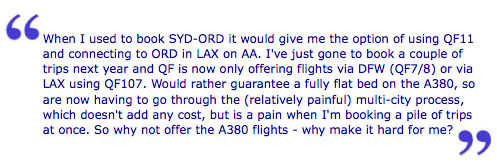I follow the Australian airline industry pretty closely and one of my favorite websites to read every day is Australian Business Traveller. This week a reader asked the question, “Why does (Qantas) not want to sell me SYD-ORD via LAX on the A380?†I plugged in some sample dates on the Australian version of Qantas.com.au to find the following results for such an itinerary:
 I’m only showing the first several options from the results page and as you can see, the top choices offer connections via Dallas-Ft. Worth and another through Los Angeles to eventually arrive in Chicago. Scrolling through the whole list, not one flight pairing included Qantas’ flagship A380 aircraft that flies from SYD-LAX, namely QF11. The original reader continues:
I’m only showing the first several options from the results page and as you can see, the top choices offer connections via Dallas-Ft. Worth and another through Los Angeles to eventually arrive in Chicago. Scrolling through the whole list, not one flight pairing included Qantas’ flagship A380 aircraft that flies from SYD-LAX, namely QF11. The original reader continues:
 Another reader, Christopher, responded, “Conspiracy theory: they want to sell more flights on the DFW route because they’re not selling well.†It’s certainly no conspiracy theory… it’s fact. Here are the two SYD-LAX nonstops with QF11 being the A380:
Another reader, Christopher, responded, “Conspiracy theory: they want to sell more flights on the DFW route because they’re not selling well.†It’s certainly no conspiracy theory… it’s fact. Here are the two SYD-LAX nonstops with QF11 being the A380:
 Los Angeles has long been the preferred destination and/or connection point for Australians visiting the United States, and Qantas knows its load factors will be high on those two flights and that they can demand a premium for the A380. I even plugged in the same Sydney to Chicago itinerary looking to purchase a Business Class fare and the resulting options still left the A380 off.
Los Angeles has long been the preferred destination and/or connection point for Australians visiting the United States, and Qantas knows its load factors will be high on those two flights and that they can demand a premium for the A380. I even plugged in the same Sydney to Chicago itinerary looking to purchase a Business Class fare and the resulting options still left the A380 off.
It makes good business sense to drive as much traffic as possible onto routes where demand is softer and as the original reader notes, booking the A380 can still be done by using the multi-city booking tool at the same price. There’s nothing illegal about it and I agree with the practice.
In fact, it happened to me when I was booking my trip to Ireland next year. My preferred flight pairings were never shown online and I had to use the multi-city tool to piece my itinerary together.
This ‘screen bias,’ if you will, isn’t new to the industry. Back when GDSs were airline-owned, carriers would display their own flight pairings – American in Sabre, for example – before any other carriers’ flights would appear. When I worked at a couple of travel wholesalers in the 1990s, I was able to ascertain this bias went even deeper and the airlines had the ability to flow preferential availability to top corporate clients. Some would see seats available in the S-bucket, for example, while others wouldn’t. I have a feeling this practice still exists today.
Airline divestiture of ownership in GDSs and other governmental action has minimized such activity, but with the increase of customer-direct bookings via the web and the development of “Direct Connect†technology to bypass traditional GDSs, airlines can still divert traffic when needed.


Having not looked at the website, but just what you’ve posted, I’d be inclined to say that it’s sorting based on duration.
I tried a couple other iterations and was never able to get QF11 to show. YMMV, of course.
I had a similar problem when trying to make an award booking from SFO to LHR on AA with a connection in LAX. When i just plugged in SFO-LHR, the LAX connection never showed, but checking LAX to LHR popped up the award seats.
Yup, it’s industry-wide and rightfully so from an airline’s perspective. Shame for the unaware, though, that they get “forced” into less-than-ideal routings.
This is smart on the part of the carriers and helps even out loads.
The pax could easily fly Virgin, Delta or United if they didn’t like what QF was doing.